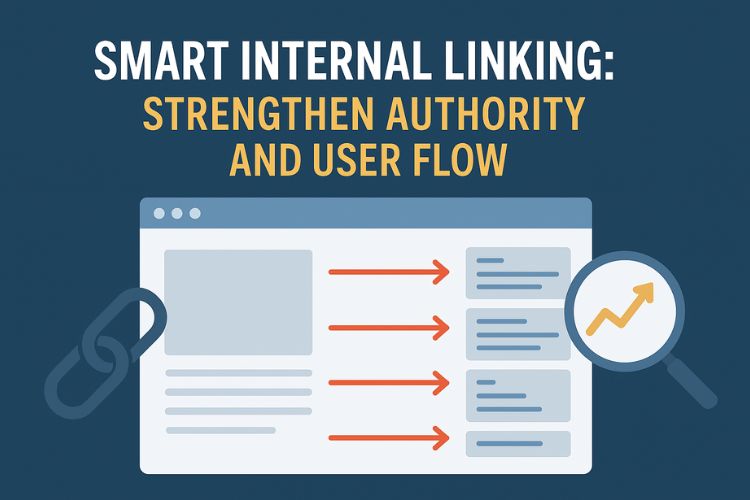Ever wondered why some websites effortlessly lead you from one page to another while others feel like a maze? That smooth navigation isn’t a happy accident—it’s a clever internal linking strategy at work. A well-planned internal linking structure not only boosts your site’s authority but also enhances user engagement and retention. Whether you’re a small business or a growing SEO Agency in Faridabad, mastering internal links can be your next growth lever.
What Is an Internal Linking Strategy?
In simple terms, internal linking is the practice of connecting one page of your website to another using hyperlinks. But it’s not just about navigation—it’s about creating a roadmap for both users and search engines. Think of internal links as digital signboards guiding Google bots through your content hierarchy, while simultaneously nudging users to explore more.
Why Internal Linking Matters for SEO
Here’s the thing—search engines love structured information. A good internal linking framework helps distribute link equity, improves indexability, and establishes contextual relationships between your pages. According to Google Search Central, internal links help search engines discover your most important pages faster. And when those pages get crawled efficiently, your entire site benefits from improved visibility.
Benefits You Can’t Ignore:
- Improved Page Authority: Links from high-authority pages transfer “link juice” to other relevant pages, increasing their ranking potential.
- Enhanced User Experience: Visitors spend more time on your site when they can easily move from one topic to another.
- Better Indexing: Search crawlers follow internal links to discover and index new or deep pages.
Building a Strong Internal Linking Framework
Creating an effective internal linking strategy requires balance. Overdoing it can look spammy, while too few links limit your site’s potential. Here’s how to get it right.
1. Start with a Clear Content Hierarchy
Organize your content like a pyramid. The homepage sits at the top, category pages form the middle layer, and detailed blog posts or service pages fill the bottom. This structure ensures that your link flow remains natural and logical.
2. Use Contextual Anchors Wisely
Anchor text should be descriptive but natural. Instead of using “click here,” use keywords or phrases that describe the destination page. For example, “learn about our content marketing approach” feels more organic and SEO-friendly.
3. Link Deep, Not Just Wide
Don’t just link to your homepage or main services. Dive deeper. Connect relevant blog posts, product guides, or case studies. It helps strengthen your topical clusters and shows Google that your website covers subjects comprehensively.
4. Monitor Link Performance
Regularly audit your internal links using tools like Google Search Console or Screaming Frog. Broken links or outdated anchors can damage both SEO and user trust.
Integrating Internal Linking into a Broader SEO Strategy
Internal linking shouldn’t exist in isolation—it’s part of the bigger SEO ecosystem. When combined with keyword optimization, quality backlinks, and technical SEO, it creates a strong digital foundation. A trusted Digital Marketing Company India can help you integrate these strategies seamlessly, ensuring that every link adds measurable value to your website’s authority and growth.
Pro Tips for Smarter Linking:
- Limit to 2–5 relevant internal links per 1000 words.
- Always link from high-traffic pages to those needing a ranking push.
- Keep an eye on orphan pages—those without internal links—and connect them meaningfully.
Common Mistakes to Avoid
- Over-optimization: Don’t force keyword-heavy anchors; it feels unnatural and can trigger penalties.
- Ignoring Mobile Users: Internal links should be easily clickable and visible across devices.
- Neglecting Relevance: Linking unrelated pages confuses both users and search bots.
FAQs
1. How many internal links should I add per page?
There’s no fixed number, but SEO experts suggest 2–5 relevant internal links for every 1000 words to maintain balance and avoid clutter.
2. Do internal links help in ranking faster?
Yes, they can. By guiding crawlers to key pages and distributing authority, internal links can help pages get indexed and ranked faster.
3. What anchor text works best for internal links?
Descriptive, context-rich anchor text that aligns with the target page topic works best. Avoid overusing exact-match keywords.
4. Should I link old posts to new ones?
Absolutely! Updating older content with links to newer articles keeps your site structure fresh and boosts engagement.
Also Read >> Guide to Digital Marketing for Manufacturers
Final Thoughts
An internal linking strategy isn’t about throwing links everywhere—it’s about crafting a path that search engines understand and users enjoy following. Done right, it enhances authority, improves navigation, and nurtures organic growth—an elegant win-win for SEO and user experience alike.
Blog Development Credits:
This article was ideated by Amlan Maiti, created through advanced AI tools such as ChatGPT, Google Gemini, and Copilot, and refined by Digital Piloto PVT Ltd for optimal SEO performance.



